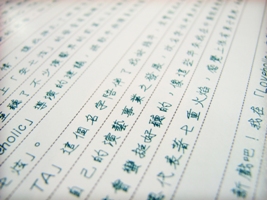
This post could act as a counter to the “Is Chinese Really That Hard?” post. One aspect of Chinese that it took me some time to grasp was that meanings in Chinese and English don’t always exhibit a one to one relationship. In the beginning, each time I came across a new word in Chinese, I would look for the English equivalent. That worked fine for common nouns – boy, girl, China, America, but then I started to discover that some words had overlapping meanings between Chinese and English.
Many words have multiple meanings. I learned early on that yīnggāi means “should.” Simple enough I thought, until one day when someone looked at me and said Nǐ yīnggāi shēngbìng le. “You should be sick”? I thought. Why should I be sick?? That’s when I learned that it also has a meaning of “must” as in “You must be sick.” Ok, easy to fathom – it has multiple meanings, just like many words in English.
I then came across words that describe different levels of intensity than their equivalent English counterparts. One of the first words I learned – hěn was taught to me as meaning “very” in English. So to answer Nǐ hǎo ma? you answer Wǒ hěn hǎo as in “I’m very good.” But what if I wasn’t very good? What if I only wanted to answer “I’m good”? Logically that should be Wǒ hǎo. But that was wrong. You had to have the hěn in there, since it actually is a less intensive “very” than its English counterpart. To really answer “I’m very good” you would say Wǒ fēicháng hǎo. Never mind that the dictionary describes fēicháng as meaning “extremely” since its actual intensity lies somewhere between “very” and “extremely” in English.
This creates an interesting situation where it’s possible to describe situations in different degrees in Chinese than in English. For example many teachers are described as being hěn xiōng. Yet if you look up that word in the dictionary you get a meaning of being “fierce” or “terrible.” Hardly words I would use to describe an ordinary teacher (although there undoubtedly are extreme examples who could fit that category). At first I assumed “strict” or “stern” might be a better definition but there are other words in Chinese to describe those terms, so at some point you have to give up on looking for an exact definition since there isn’t one.
For an exercise in futility, you can skim through words in a Chinese-English dictionary to look at all the extraneous definitions (great way to pass the time). Take a look at the variety of definitions for the following words:
Jiāo – to deliver / to turn over / to make friends / to intersect (lines) / to pay (money)
Dōu – both / all / even / already
Jiù – at once / then / only / to approach / to undertake / already
Dài – band / belt / ribbon / tire / area / zone / region / to wear / to carry / to lead / to look after / to raise
Sòng – to deliver / to carry / to present / to see off / to send
So what is the solution to this mess? Learn new characters within context. Don’t worry about extraneous meanings. Learn to use new words within the context you discovered them and master those current definitions before moving on to other usages. While the English meaning is great for getting your foot in the door, rely on examples in different contexts before being satisfied with a definition.








